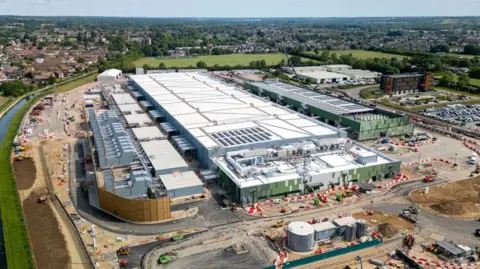### Expansion of Data Centres in the UK Amid Growing Concerns
In a significant shift within the technology infrastructure landscape, the UK is set to experience a remarkable rise in data centres, with projections suggesting a nearly 20% increase in the total number across the country. This information, recently presented by BBC News, highlights the increasing necessity for such facilities as digital services continue to proliferate. Currently, there are an estimated 477 data centres in the UK, which play a crucial role in supporting various online services, such as movie streaming and online banking.
The rise in the number of data centres is primarily influenced by the burgeoning demand for artificial intelligence (AI) technologies. Analysts from construction research firm Barbour indicate that approximately 100 new centres are on the horizon, primarily due to the escalating need for enhanced processing power. The majority of these facilities are expected to be operational within the next five years, heralding a new era of digital infrastructure.
However, the rapid expansion of data centres has sparked significant concerns surrounding their environmental and energy impact. As these facilities require large amounts of energy and water for their operations, there are fears that this demand could inflate consumer energy prices. Experts warn that the surge in data centres in London and its neighbouring counties could exacerbate the strain on local resources, especially considering more than half of the new projects will be concentrated in this area.
Many of these data centres are being financed by US tech heavyweight companies like Google and Microsoft, along with substantial investment firms, further emphasizing the financial muscle behind this expansion. This trend is not limited to England; Wales will see the establishment of nine new centres, with a single facility also planned for Scotland. Beyond that, Greater Manchester is projected to host five new centres, while additional developments are anticipated across the broader UK landscape.
Among the most ambitious projects is a forthcoming £10 billion AI data centre to be built in Blyth, near Newcastle, overseen by the Blackstone Group. This facility will comprise ten immense buildings, spanning 540,000 square meters—the equivalent of several large shopping centres. Construction on this major site is slated to commence in 2031 and will span more than three years.
### Growing Concerns Over Energy Use
The energy consumption associated with these new data centres remains a significant unknown. Historical data from the US indicates that newer centres often consume considerably more electricity than older facilities; therefore, the UK expects to see a similar trend. Dr. Sasha Luccioni, an AI and climate specialist at Hugging Face, elucidates the potential ramifications, citing cases in the US where monthly bills for average citizens rose significantly due to the energy demands of nearby data centres.
Further complicating matters is the potential impact on water resources. Data centres often necessitate substantial water supplies for cooling systems, yet many of the current facilities do not disclose their water usage. The CEO of the Data Centre Alliance, Stephen Hone, acknowledges these challenges but emphasizes the industry’s commitment to sustainability. To mitigate environmental effects, some new centres are pursuing dry-cooling strategies; however, these initiatives have not quelled public concerns, as seen in Potters Bar, Hertfordshire, where residents have actively protested against a large data centre slated for construction on greenbelt land.
Additionally, concerns have arisen in Dublin, where local authorities have imposed a moratorium on new data centre developments due to existing centres straining Ireland’s national electricity supply. This issue is echoed in reports indicating that data centres accounted for one-fifth of the country’s total energy demand in recent years.
### Infrastructure and Economic Implications
The UK government has recognized the strategic importance of data centres, designating them as critical national infrastructure. However, it remains to be seen how the escalating demands of these facilities will be met. The UK’s National System Operator has projected that the growth of data centres could lead to a significant increase in electricity demand—up to 71 terawatt-hours (TWh) over the next quarter-century. This rise intensifies the urgent need for cleaner energy solutions, such as offshore wind capabilities.
In response to these pressing needs, the government has pledged substantial investments—£104 billion—into water supply infrastructure and has launched an AI Energy Council, aimed at aligning supply capabilities with the anticipated demand from new data centres.
In summary, the planned expansion of data centres across the UK marks a shifting landscape driven by technological advancements, particularly in AI. While the potential economic benefits and advancements in digital services are significant, they come with a host of environmental and infrastructural challenges that must be addressed through careful planning and innovative solutions. As the demand for digital services continues to grow, a balanced approach will be crucial to ensuring sustainable development in this vital sector.











